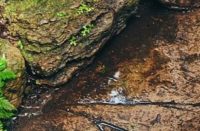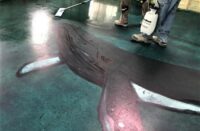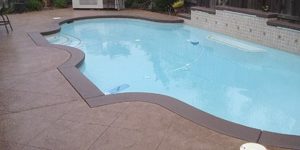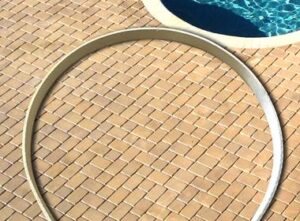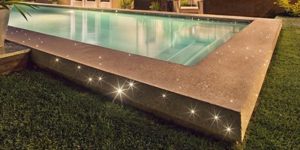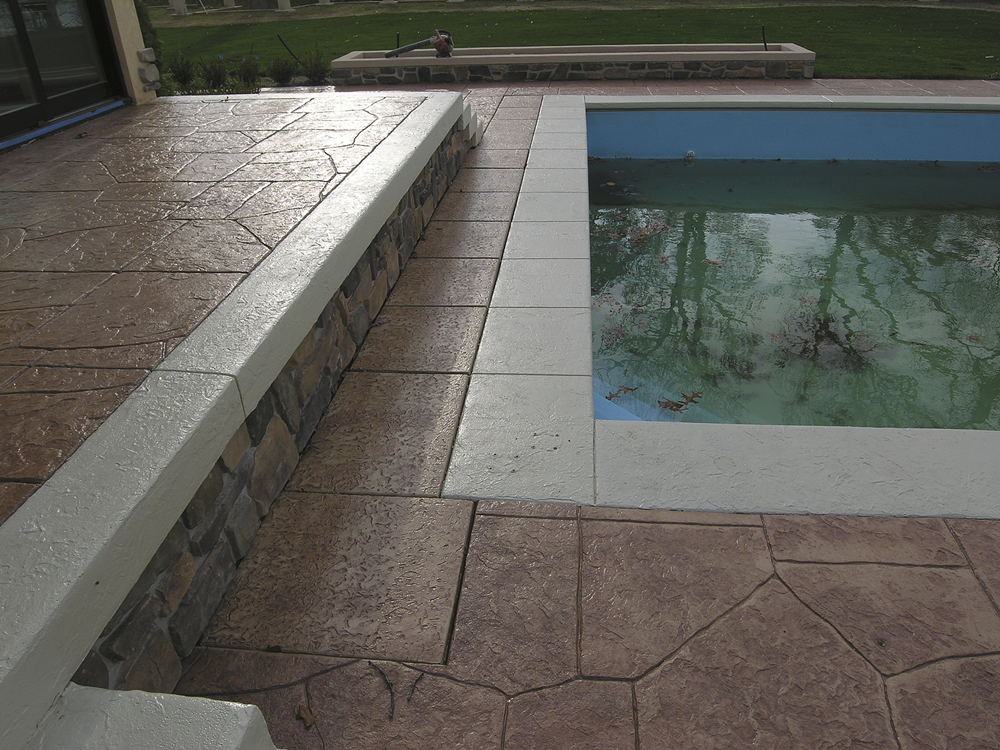
The combination of pools and stamped concrete doesn’t necessarily spell disaster. For one thing, when a stamped concrete surface near a pool is slick, a topical sealer, not the texture, is often the culprit. That’s good to know when you’re hoping to keep customers from slipping on their new surface, and is very important to consider before you begin fixing slippery stamped concrete.
There are several techniques and products you can use to make a stamped surface less slippery when wet. One of the standard methods involves mixing a nonslip additive such as SureCrete’s SureGrip, H&C SharkGrip or Matcrete’s Rhino Grip into the water- or solvent-based acrylic sealer before rolling it on. You can also broadcast more of the ground-up polymer onto the wet surface while the sealer is still tacky. Some products are available in different particle sizes for more traction or less.
Less slippery vs. slip-free
But “less slippery” does not mean slip-free. “We’ve found that these products work OK,” says Tim Kisielnicki, president of Colorado Flatwork Inc., Colorado Springs, a sentiment echoed by many other contractors across the country. “They improve the surface, but by no means do you then have a nonslip surface.”
He says he’s tried adding glass beads, silica, sand and aluminum oxide to sealers for fixing slippery stamped concrete and they all work about the same. “They help, but the surface is still slippery.”
Kisielnicki says he’s had more success broadcasting nonslip additives onto wet sealers than mixing the two together. However, he found that, to get enough texture on the surface to effectively work, he had to add so much product that it discolored the surface, creating an unappealing white powder-like film.
“We’ve probably stamped concrete around 15 pools in the last 10 years,” he says. “And one of the things I tell my clients is that it will be slippery when wet. It’s up to them to decide if it’s something they can live with.”
The color hardener route
Other contractors, such as Neil Roach, president and CEO of Creative Construction By Design, Danville, Ill., have found a method they say works for them.
“We like to broadcast a light coat of color hardener just prior to applying the release and stamping. We don’t trowel it in — we just throw it on,” Roach says. “This is a more permanent slip-reduction technique, rather than putting a polymer grit in the sealer. It embeds a little bit of aggregate into the stamped surface.”
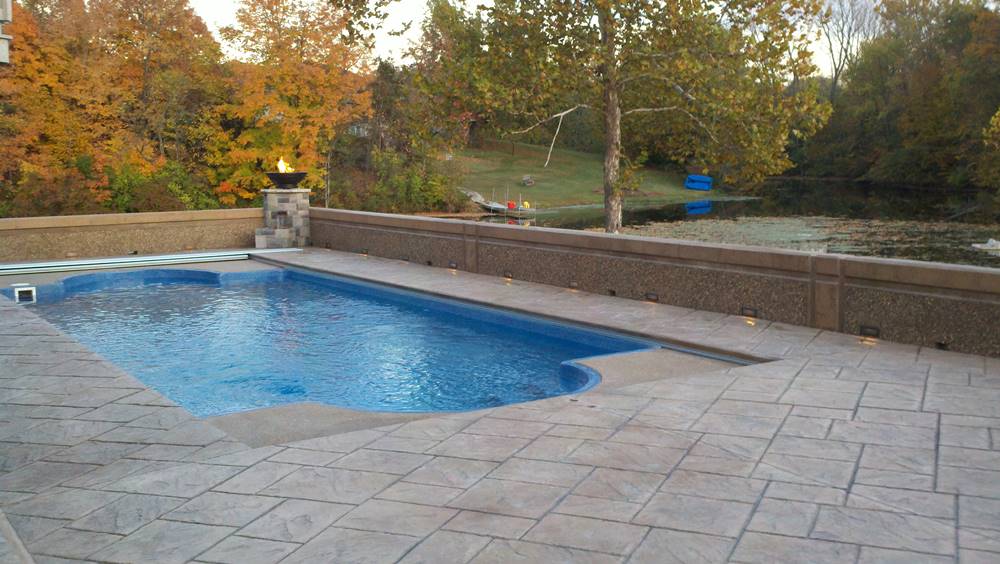
Seeding the concrete with color hardener has advantages over combining a sealer with additives, Roach says. “It’s not as prominent as polymer grit broadcasted on the sealer. It also doesn’t wear off to the same extent as a sealer. When a sealer breaks down, you lose the additive as well.”
Besides seeding to help with slip resistance, Roach advises contractors to keep the concrete surface’s slope minimal. “Keep the grade as minimal as possible to increase the coefficient of friction but still control the flow of the surface water. Also, try to use patterns that have a more aggressive texture in the stone.”
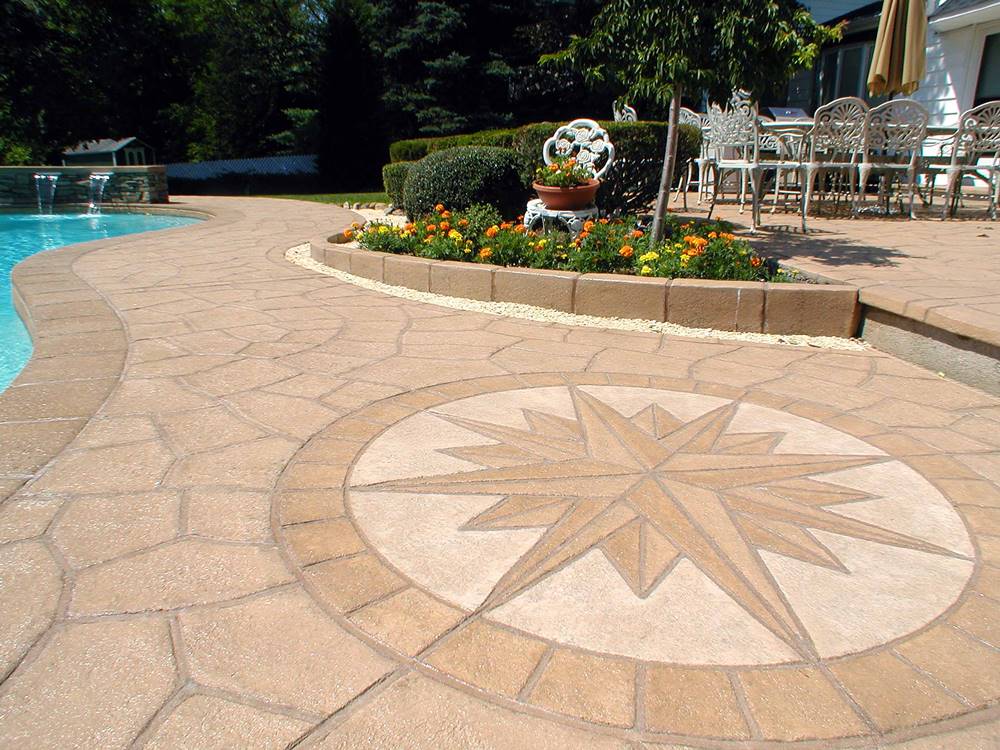
Better sealer and stamp choices
Carol Brown, director of operations for Overland Concrete Construction, in Olathe, Kan., says pool-deck contractors should avoid stamp patterns such as random stone that are too flat, especially if clients prefer the look of an acrylic sealer.
“You can successfully use acrylic sealers on stamped concrete, but use one with low solids and a slip-resistant additive,” she says. Her company has been successfully using Certi-Vex AC1315, a slip-resistant acrylic sealer from Vexcon Chemicals.
For even more slip resistance, you can add ground-up polymer such as SureGrip to the Vexcon product, she says, but no more than 3 ounces per gallon. “Sealers tend to be problematic as is. When you start adding other things to them, you have to be careful not to create a new problem.”
If clients are really concerned about a slick surface, they should opt for a penetrating instead of an acrylic sealer. She says she has used Hydrozo Silane 40, a penetrating sealer from BASF, with good results. A silane sealer won’t affect the color of the concrete or increase the gloss. This make it a great choice for those seeking the look of natural stone, she adds.
Brown also cautions contractors to be aware of the amount of acrylic sealer they are putting down. “The more you put down, the smoother and slipperier the surface gets. Too much and you’ll get sealer failure.”
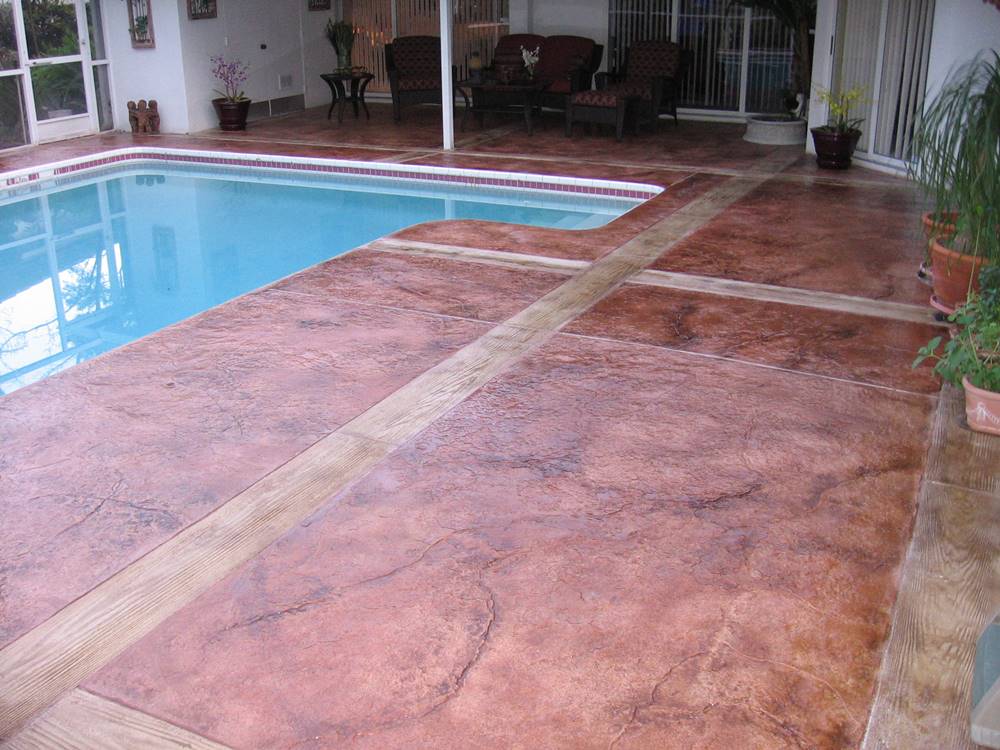
Aluminum oxide grit
Finely ground polymer materials aren’t the grit additives of choice for everyone, says Scott Hubbard, sales manager for Sundek of Austin, Texas. He prefers to broadcast or integrate aluminum oxide into his company’s sealers to make a surface less slick. He likes broadcasting best, he adds, because he can achieve a heavier coverage.
“I think aluminum oxide works better,” he says about the powdery substance. “It’s less expensive and you can get it in multiple colors. And you don’t get that hazy look like you get with SharkGrip.”
Hubbard says he usually uses Sundek’s 18 percent or 30 percent solids solvent-based acrylic sealer on stamped surfaces. “Overall, I prefer the 30,” he says. “The 18 percent is not as slick around a pool but it has to be applied more often because it’s not as durable. A clear seal with less solids doesn’t give as much protection.”
Clear acrylic sealers with aluminum oxide additives will eventually wear away. On average, Hubbard estimates, they need to be resealed every two to three years, depending on foor traffic and exposure to UV rays.
Concentrate on the concrete
Todd Fisher, a member of the family-run business Unique Concrete NJ, based in West Milford, N.J., approaches the slippery sealer quandary from a different perspective.
“We concentrate on making the concrete itself better and relying less on sealers,” he says, adding that all their new installations involve integrally colored, densified concrete and usually water-based sealers. “My advice is to make the color as permanent as possible and the concrete as durable as possible so you don’t have to rely on the sealer to make a project functional.”
There are some situations such as driveways and high-traffic areas, Fisher concedes, where the job calls for a solvent-based acrylic sealer. That’s the way he’ll go.
“Ideally I thin a sealer down to as little solids as possible. Then I treat it almost like a wax and apply it on a maintenance schedule. But we are not dealing with ideal situations,” he says. “Usually, we thin all of our sealers down to about 15 percent. It is a nice number for preserving texture and staying away from a plastic build.”
Even more slip-resistance
To further lessen the degree of slipperiness, he trowels and uses Unique’s specially made rollers. “We rely heavily on the texture of our concrete to provide slip resistance,” Fisher says.
Even placement tool choices can curb slipperiness. “Instead of using a fresno or hand trowel to finish the slab in preparation for stamping … use only a float,” states artisan Steve VandeWater on the website of the Indiana Decorative Concrete Network. “While many stampers prefer a very smooth finish to give them a ‘fresh canvas’ for texturing, troweling a slab makes it overly slick. Simply floating the concrete instead leaves a sandier finish, which aids with slip resistance. As a bonus, it can also make the texture look more realistic, especially on stone or brick patterns.”
Question from Readers
Question
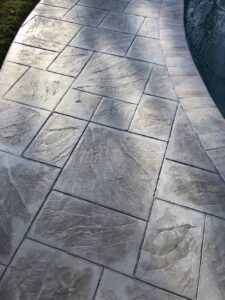 We had a stamped concrete pool deck put down last fall and people were slipping quite a bit. Now we’re nervous to open the brand new pool! Can we seal the deck again using an additive as recommended above this time? If so, what are the best products to use?
We had a stamped concrete pool deck put down last fall and people were slipping quite a bit. Now we’re nervous to open the brand new pool! Can we seal the deck again using an additive as recommended above this time? If so, what are the best products to use?
Answer from Concrete Decor
I recommend using a slip resistant additive in a new coat of sealer to the existing surface. Do you know the brand name and type of sealer that was previously used? Also, what is the total area in square footage that you need to treat?

